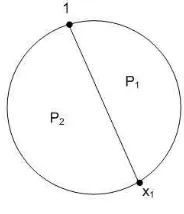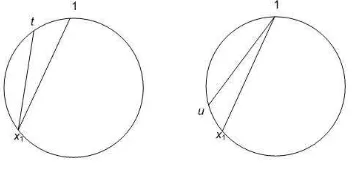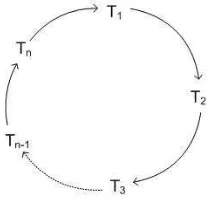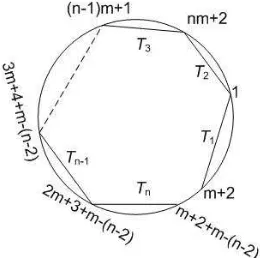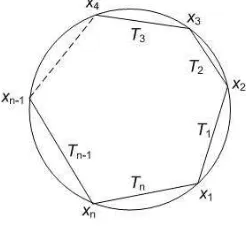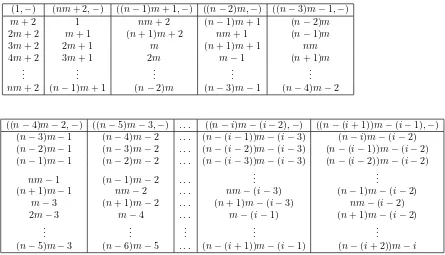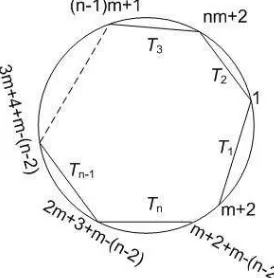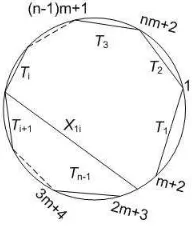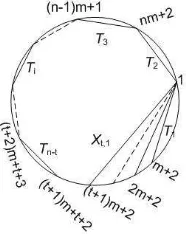Vol. 22, No. 2 (2016), pp. 93–130.
Abstract. For any natural natural numberm, them-cluster tilted algebras are generalization of cluster tilted algebras. These class algebras are defined as the endomorphism of certain object inm-cluster category calledm-cluster tilting object. Finding such object in them-cluster category has become a combinatorial problem. In this article we characterize Nakayamam-cluster tilted algebras of typeAn by geometric description given by Baur and Marsh.
Key words and Phrases: Cluster tilted algebras, cluster category, tilting object, Nakayama algebra
Abstrak. Untuk setiap bilangan aslim, aljabar teralihm-kluster adalah general-isasi dari aljabar teralih kluster. Kelas aljabar ini didefinisikan sebagai endomor-fisma objek tertentu di kategorim-kluster yang disebut objek pengalihm-kluster. Mencari objek tersebut dalam kategorim-kluster dapat menjadi masalah kombina-torial. Dalam artikel ini dikarakterisasi aljabar Nakayama yang merupakan aljabar teralihm-kluster jenisAnberdasarkan deskripsi geometris yang diberikan oleh Baur dan Marsh.
Kata kunci: aljabar teralih kluster, kategori kluster, objek pengalih, aljabar Nakayama.
1. Introduction
LetKbe an algebraically closed field, andQa finite acyclic quiver withn ver-tices. LetDb(H) be a bounded derived category of modH whereHis a basic, finite dimensional hereditary algebra overK. We can assumeHas a path algebraKQof some quiverQ. Them-cluster category is the orbit categoryCm
H =Db(H)/τ
−1[m]
whereτ is the Auslander-Reiten translation ofDb(H) and [m] denotesm-th power of shift [1] in the derived categoryDb(H). Them-cluster category is triangulated
2000 Mathematics Subject Classification: 16G70.
[5] and it is a Krull-Schmidt category [2]. These categories are generalization of cluster categories defined in [2] and independently [3] for the Dynkin typeAn case. Inm-cluster category we consider a class of objects called m-cluster tilting objects. These objects have nice combinatorial properties. By definition, an object
T is an m-cluster tilting object if for any object X, we have X ∈ addT if only if Exti
Cm
H(T, X) = 0 for all i ∈ {1,2, . . . , m}. The objects T always have exactly
n indecomposable direct summands [7]. The endomorphism algebra EndopCm H(T) is
called m-cluster tilted algebra.
In this paper we investigatem-Cluster Tilted Algebras(m-CTA) of typeAn which are Nakayama algebras. Nakayama algebra itself by its quiver is divided into two types, namely typeAn and cyclic. In this paper we focus onm-CTAs which are Nakayama algebras of type An and all possible relations as from [6] we have known all m-CTAs which are Nakayama algebras of type cyclic, see also [4]. In order to do this we use the geometric description ofm-cluster category typeAn in [1]. We will divide into three cases in the search ofm-CTAs of typeAn. We divide these two cases based on the relationship betweenmandn. The first case is when
m≥n−2, the second case is m < n−2.
This article is organized as follows. In Section 2 we describe the geomet-ric description and the relations of Nakayama m-CTAs; in Section 3 we give a characterization of Nakayama m-CTA of cyclic type; in Section 4 we give a char-acterization of Nakayama m-CTA of acyclic type which will be divided into two cases.
2. Geometric Description and Relations in Nakayama m-CTAs
The geometric description ofm-cluster category typeAn in [1] briefly repre-senting indecomposable objects and arrows of the AR-quiver ofm-cluster category in a regular gon. The indecomposable object is described as a diagonal of a regular gon while an arrow between two indecomposable objects described as two diagonals that have a common endpoint. From this geometric description we can also see the relations of quivers of them-CTAs of typeAn.
Let Pm(n+1)+2 be (m(n+ 1) + 2)-regular gon, m, n ∈ N, where its corner
clockwise. Note that if j is a clockwise direct neighbor of i then arc Dij is an edge ij of Pm(n+1)+2. We always have two arcs Dij, Dji. Let ΓmAn be a quiver
with the vertices are allm-diagonals of polygonPm(n+1)+2 while arrows obtained
in the following way: suppose D = (i, j) and D′ = (i, j′) are m-diagonals which
together with arc fromj toj′ form (m+ 2)-gon inP
m(n+1)+2andDcan be rotated
clockwise toD′ about the common endpointi.
Using this regular gon we can easily make a quiver of anm-CTA. The set of indecomposable objects of a tilting object ofm-cluster category of typeAn can be identified as the set of maximalm-diagonals inPm(n+1)+2and the number of direct
summands of this object is alwaysn. Such a set is called an (m+ 2)−angulation of Pm(n+1)+2. By definition, we can conclude that ifX and Y arem-diagonals of a
tilting objectT that has a common endpoint then there is a path fromTX andTY in the Auslander-Reiten(AR) quiver of m-cluster category where TX and TY are indecomposable objects associated to X and Y. It is clear that the composition of the arrows in this path is not zero. If there is no m-diagonal between X and
Y inPm(n+1)+2 then the composition of irreducible maps fromTX toTY does not pass through another indecomposable object which is a direct summand of a tilting object T. It means that there is an arrow from the point corresponding to X and
Y in the quiver of m-CTA Endop(T).
By the above argument we can define a quiver of anm-CTA independently from (m+ 2)-angulation of Pm(n+1)+2. Let T ={T1, T2, . . . , Tn} be an (m+ 2)-angulation. Define a quiver QT as follows: The vertices of QT are the numbers 1,2, . . . , nwhich are in bijective correspondence with them-diagonalsT1, T2, . . . , Tn. Given two verticesa, bofQT, there is an arrow fromato bif
(i) Ta andTb have a common point inPm(n+1)+2,
(ii) there is nom-diagonal ofT betweenTa and Tb and
(iii) Ta can be rotated clockwise toTb at the common endpoint.
Our first lemma characterize the possible forms of twom-diagonals in polygon Pm(n+1)+2, correspond to a path of length two in the quiver of anm-CTA. We have
the following easy lemma.
Lemma 2.1. LetH =Endop(T)be anm-CTA withT is anm-cluster tilting object of Cm
An. Ifx→y→z is a path of length two inQH andTx, Ty, Tz respectively are
m-diagonals correspond to points x, y, zthen
(1) Tx= (x1, x2), Ty = (x2, x3), Tz= (x3, x4) withx4 in arcDx3x1
or
(2) Tx= (x1, x2), Ty = (x2, x3), Tz= (x2, x4) withx4 in arcDx3x2,
wherexi6=xj ifi6=j.
Proof. LetTx= (x1, x2). Since there is an arrow fromxtoy thenTxandTy have a common endpoint. Without loss of generality, supposeTy = (x2, x3). Since there
is an arrow fromytozthenTyandTzhave a common endpoint. Ifx3is a common
endpoint ofTy andTz thenTz= (x3, x4) wherex4 in arcDx1x3, otherwiseTz will
crossTx. Ifx2 is a common endpoint ofTy andTz thenTz = (x2, x4) where x4 in
arcDx3x2.
letQbe the collection of maximal connected subquivers ofQ. It can be shown that
H = Y
Q′∈Q
KQ′/I′ whereI′ is an ideal ofQ′, but thenH is a finite direct product
of some algebras. Hence,H is not connected.
In order to know the condition of an (m+ 2)-angulation such that the quiver ofm-cluster tilted algebra is connected, we have the following easy lemma.
Lemma 2.2. Let T be an (m+ 2)-angulation of Pm(n+1)+2. The graph generated
by the diagonals inT is connected if only if the quiverQT is connected.
Let X = (x1, x2) be a diagonal of Pm(n+1)+2. We may assume x2 > x1.
Define the length of diagonalX to be the min{x2−x1, m(n+ 1) + 2 +x1−x2}.
Thus, the length ofX is equal to the minimum of the number of sides between arc
Dx1x2 andDx2x1. Anm-diagonalX ofPm(n+1)+2 is said to beshortif its length
Figure 1. short m-diagonal
is minimal, that is of lengthm+ 1. Anm-diagonalX is short if only if there is no
m-diagonal whose endpoints are in smaller polygon divided byX.
Lemma 2.3. Let T be an(m+ 2)-angulation of Pm(n+1)+2 with n≥3. If QT is cyclic then allm-diagonals inT are short.
Proof. LetX be anm-diagonal ofT which is not short . Without loss of generality, letX = (1, x1) andX has length which is minimal among the diagonals inT which
are not short . First, assume that x1 ≤ m(n+ 1) + 2
2 . The diagonal X will divide Pm(n+1)+2 into two smaller polygons P1 and P2 with P1 is the smallest
polygon (see Figure 2). Since X is not short and T is maximal, there exists an
m-diagonal of T whose endpoints in arc Dx1x2. By the same argument we also
have anotherm-diagonal ofT which divides the polygonP2. We then have that all
m-diagonals in P1 are short by the minimality ofX. SinceQT is connected there exists a shortm-diagonalX1 ofT inP1 that adjacent toX. We may assume that
X1= (1, b). Now there exists a shortm-diagonal that adjacent toX1, namelyX2.
By the same argument we have a collection of shortm-diagonalsX1= (1, a1), X2=
Figure 2. m-diagonalX
to this property. It follows that xk =x1, otherwise there is no arrow which target
isXk inQT. We describe this situation in the following figure
Figure 3. m-diagonals inP1
But now we have a pathX1→X →Xk in QT. So there can be no further
m-diagonals adjacent toX, which is a contradiction.
Ifx1>
m(n+ 1) + 2
2 we get similar proof forP2since in this caseP2becomes
the smallest polygon divided byX.
Lemma 2.3 gives us a characterization ofm-cluster tilting object such that the correspondingm-CTA is a Nakayama algebra of cyclic type. We will find all
m-cluster tilting objects in this form in the next section. Now we look at the configuration of an (m+ 2)-angulationT whichQT is ofAn type.
Lemma 2.4. Let T be an(m+ 2)-angulation of Pm(n+1)+2 with n≥3. If QT is of An type then
for some r ≥2 where (up to rotation) TC ={(1, x1),(x1, x2), . . . ,(xr−1, xr)} and all m-diagonals inTC are short,
Tα1 ={(x1, y11),(x1, y12), . . . ,(x1, y1j1)}, j1≥0
Tα2 ={(x2, y21),(x1, y22), . . . ,(x1, y2j2)}, j2≥0
.. .
Tαr−1={(xr−1, yr−1,1),(x1, yr−1,2), . . . ,(xr−1, yr−1,jr−1)}, jr−1≥0
with y11< y12<· · ·< y1j1 < y21<· · ·< y2j2 <· · ·< yn−1,jn−1.
Figure 4. (m+ 2)-angulation ofT withQT =An
Proof. Let (1, x1) be an m-diagonal of Pm(n+1)+2 correspond to a source in QT. We claim that (1, x1) is short. If (1, x1) is not short then either there is an m
-diagonal (x1, t) witht > x1or there is anmdiagonal (1, u) withu > x1(see Figure
5). Consider the first case , if there is an m-diagonal (x1, t), we choset maximal
Figure 5. m-diagonals (x1, t) and (1, u)
such thatt > x1. Then we have an arrow (x1, t)→(1, x1), but it contradicts that
(1, x1) is a source. Second case, if there is anm-diagonal (1, u) we choseuminimal
with 1 < a < x1 or an m-diagonal (1, b) with 1 < b < x1. We may assume that
a is minimal andb maximal. If there is a diagonal (x1, a) then there is an arrow
(1, b)→(x1, a). It contradicts the fact that there is also an arrow (1, x1)→(1, u).
So we can assume that there is a diagonal (1, b). It follows that there is an arrow (1, b)→(1, x1). This is a contradiction since (1, x1) is a source. Therefore (1, x1)
is short, this proves our claim.
Let (1, x1)→(x1, z) be the arrow starting in (1, x1) then z >1. Now there
are two cases, either (x1, z) is short or (x1, z) is not short.
Figure 6. m-diagonal (x1, z)
(1) (x1, z)is short.
IfTα= (x1, z) is short then arcDzx1 together withTαis a smaller polygon
divided by (x1, z). Hence, there is no m-diagonal with endpoints in arc
Dzx1. We also have that there is no m-diagonal (x1, y) with 1 < y < z
since otherwise the arrow (1, x1)→(x1, z) will not exist.
(2) (x1, z)is not short.
If (x1, z) is not short then there is no m-diagonal (z, v) with 1 < v < z.
Indeed, assume to the contrary that there is an m-diagonal (z, v) with 1 < v < z. It follows that there is no m-diagonal (x1, u) for z < u < x1
since otherwise there is also an arrow (x1, z)→ (x1, u). If there is anm
-diagonal (z, l) forz < l < x1, and choosezmaximal, then there is an arrow
(z, l) → (x1, z), a contradiction. Therefore there is no m-diagonal with
endpoints in arc Dzx1. This is a contradiction since (x1, z) is not short.
Hence there is no diagonal (z, v). Therefore arc D1z together with (1, x1)
and (x1, z) forms an (m+ 2)-gon.
We describe condition 1 and 2 respectively as follows
Indeed, in case (x1, z) is short then the arrow starting at (x1, z) is (x1, z)→(z, w)
with 1 < w < z. In case (x1, z) is not short then the arrow starting at (x1, z) is
(x1, z)→(x1, w) with 1< w < x. We have similar case for the third m-diagonal
from the source which adjacent to (x1, z). There are again two cases to consider,
that is either thism-diagonal is short or not short. These two cases will be similar to the condition 1 and 2 above. We complete the proof by induction using the fact that the the next m-diagonal adjacent to the previous have two possibilities like
condition 1 and 2.
Two cases in Lemma 2.1 hold for any path of length two in the quiver of
m-CTAs of typeAn. For both cases the picture is as follows
Figure 7. m-diagonals correspond a path of length two
Using the above lemma we can conclude that each path of length two in the quiver ofm-CTAs of typeAn is one of these two cases.
Now we will see the composition of paths of length two in End (T)∼=KQ/I for both cases. We have the following facts.
Lemma 2.5. Let T =T1⊕T2⊕ · · · ⊕Tn be anm-cluster tilting object of CAmn and
Qbe a quiver ofm-CTA Endop(T). Supposei−→α j −→β kis a path of length two in
Qcorresponding to them-diagonalsTi, Tj, Tk inPm(n+1)+2.
(1) IfTi = (x1, x2), Tj = (x2, x3), Tk = (x3, x4)with x4 in arcDx3x1 then the
compositioni−→α j−→β k in Endop(T)is zero.
(2) IfTx= (x1, x2), Ty = (x2, x3), Tz = (x2, x4)with x4 in arc Dx3x2 then the
compositioni−→α j−→β k in Endop(T)is not zero.
Proof. See [4].
Now we can identify the relation of connected Nakayama m-cluster tilted algebras using Lemma 2.3, 2.4 and 2.5.
Theorem 2.6. LetH =KQ/I be a connected Nakayama m-cluster tilted algebra of Cm
An. An idealI of H is generated by a relation of paths of length two.
QT is in case 1 of Lemma 2.1. By Lemma 2.5 all paths of length two is zero. If
Q is of type An then by Lemma 2.4 every path of length two is either case one or case two of Lemma 2.5. It remains to prove that every path P = α1α2. . . αℓ
withℓ≥3 is not zero in H if every subpath ofP is not zero inH. It follows that
every subpath of length two inP is case two of Lemma 2.5. We may assume that Tα1 = (1, mr+ 2) with 1≤r < nwhose common endpoint withTα2 andTα3 is 1.
Hence, Tαj = (1, mrj+ 2) for every j ≥2 with r < ri < ri+1 for all i. We have
that Tα1, Tα2, . . . , Tαℓ will be in the subquiver of Γ
m
An as in Figure 8. Since the
Figure 8. subquiver of Γm An
composition of irreducible morphismTα1 →Tα2 → · · · →αℓ is not zero inm-cluster
category, we conclude thatα1α2. . . αℓnot zero inH. This finishes the proof.
3. m-CTAs which are Nakayama Algebra of Cyclic Type
In this section we will show thatm-CTAs which are Nakayama algebras of cyclic type only occur ifm=n−2. It means that there is nom-CTA whose quiver is cyclic when m 6= n−2. In addition, in m-CTA there is only one possibility relation that is relations of paths of length two. More generally, m-CTAs which have cyclic quivers have been stated by Murphy in [6]. However, in this section we explain how to characterize m-CTAs which quivers are cyclic by using geometric description in [1]. The results in this section have been proved in [4]. We state again here with more structured proofs.
We show that ifT =T1⊕T2⊕ · · · ⊕Tn thenT is am-cluster tilting object form≥n+ 2 whereTi’s arem-diagonals described in Proposition 3.1. The quivers ofm-CTAs Endop(T) have different forms for each casem=n−2 andm > n−2. Indeed, for 1 ≤ i ≤ n−1 diagonals Ti and Ti+1 have a common endpoint in
the quiver of Endop(T). Now considerm-diagonalsT
n= (3m−(n−5),2m−(n−4)) and T1 = (1, m+ 2). Ifm=n−2 thenTn = (2m+ 3, m+ 2). Hence,Tn andT1
have a common endpoint (m+ 2) in Pm(n+1)+2. Therefore there exists an arrow
n→1 in quiver of Endop(T). Thus, for m=n−2 the quiver of m-cluster tilted algebra Endop(T) is Figure 9.
Figure 9. Quiver of Endop(T) form=n−2
Proposition 3.1. Let Cm An =D
b(KA
n)/Fm, where Fm=τ−1[m] andm=n−2. Suppose that T1= (1, m+ 2), T2= (1, nm+ 2)and for3≤i≤n,
Ti= ((n−(i−2))m−(i−4),(n−(i−3))m−(i−5))
then
(1) T1, T2, . . . , Tn arem-diagonals ofPm(n+1)+2.
(2) T =T1⊕T2⊕ · · · ⊕Tn is an m-cluster tilting object.
(3) m-cluster tilted algebra Endop(T)is isomorphic toKQ/I whereQis cyclic with nvertices andI is an ideal generated by all paths of length two.
Proof. It is clear that ifT1= (1, m+ 2), T2= (1, nm+ 2) and for 3≤i≤n,
Ti= ((n−(i−2))m−(i−4),(n−(i−3))m−(i−5))
then T1, T2, . . . , Tn are m-diagonals of Pm(n+1)+2. For i =n we have that Tn = ((n−(n−2))m−(n−4),(n−(n−3))m−(n−5)) = (3m−(n−5),2m−(n− 4)). Consider m-diagonals T1, T2, . . . , Tn in Pm(n+1)+2, see Figure 10. Because
T1, T2. . . , Tn are not crossing each other then T is anm-cluster tilting object. Let
Q be a quiver of m-cluster tilted algebra Endop(T), then there is only one arrow
i→i+1 for every 1≤i≤n−1. Sincem=n−2, we obtain thatTn= (2m+3, m+2) and T1 = (1, m+ 2) have a common endpoint. Consequently, there is exactly one
arrown→1 in Q. It means thatQis a cyclic quiver with nvertices. By Lemma
2.5 the composition of all paths of length two is zero.
Figure 10. m-diagonalsT1, T2, . . . , Tn
Proposition 3.2. IfT is anm-cluster tilting object ofm-cluster categoryCm An such
that the quiver of m-cluster tilted algebra Endop(T) is connected and cyclic, then
m=n−2. Moreover, Endop(T) =KQ/I with I an ideal generated by all paths of length two.
Proof. Let Q be a quiver of m-cluster tilted algebra Endop(T). Suppose T =
T1⊕T2⊕ · · · ⊕Tn,we may assume{T1, T2, . . . , Tn}is a set of maximal non-crossing
m-diagonals in (m(n+ 1) + 2)-gonPm(n+1)+2. Assume thatQ0={T1, T2, . . . , Tn} the set of vertices of Q, and the set of arrows Q1 = {α1, α2, . . . , αn−1, αn} with
αi : Ti → Ti+1 for every i ∈ {1,2, . . . , n−1} and αn : Tn → T1. Consider any
path of length two Tp → Tq → Tr in Q. By Lemma 2.3 Tq, Tr, Ts are short. It follows thatTq = (x1, x2), Tr= (x2, x3), Ts= (x3, x4) can be described as in Figure
11. By applying the above argument, the picture of m-diagonalsT1, T2, . . . , Tn in
Figure 11. m-diagonals correspond toTq, TrandTs
Figure 12. m-diagonalsT1, T2, . . . , Tn form=n−2
Since all Ti are short then the length of Ti is m+ 1. Consequently, we have the equation
(m+ 1) + (m+ 1) +· · ·+ (m+ 1)
| {z }
n
=m(n+ 1) + 2.
Therefore,
(m+ 1)n=m(n+ 1) + 2⇔n=m+ 2
For the last statement we apply Lemma 3.1.
Example 3.3. Letm= 4andn= 6thenm(n+1)+2 = 4(6+1)+2 = 30. Consider 30-gon P30, let T1 = (1,6), T2 = (1,26), T3 = (26,21), T4 = (21,16), T5 = (16,11)
andT6= (11,6)then T =T1⊕T2⊕T3⊕T4⊕T5⊕T6 is a 4-cluster tilting object.
The picture ofP30 together with the sixm-diagonals is
4. m-CTAs which are Nakayama Algebras with Acyclic Quivers
In this section we will characterize m-CTA which are Nakayama algebras whose quivers are connected acyclic. In other words, we find m-cluster tilting objectsT =T1⊕T2⊕ · · · ⊕Tn such that Endop(T)∼=KQ/I whereQis
T1−→α1 T2−→α2 T3→ · · · →Tn−1 αn−1
−−−→Tn.
Throughout,Qis assumed to be the above quiver, unless otherwise specified. We will also observe the relation in this type ofm-CTA. To do this we divide into two cases correspond to m and n. These three cases are m ≥ n−2 and
m < n−2.
The following is the list ofm-diagonals inPm(n+1)+2.
Table 1. m-diagonals
(1,−) (nm+ 2,−) ((n−1)m+ 1,−) ((n−2)m,−) ((n−3)m−1,−)
m+ 2 1 nm+ 2 (n−1)m+ 1 (n−2)m
2m+ 2 m+ 1 (n+ 1)m+ 2 nm+ 1 (n−1)m
3m+ 2 2m+ 1 m (n+ 1)m+ 1 nm
4m+ 2 3m+ 1 2m m−1 (n+ 1)m
..
. ... ... ... ...
nm+ 2 (n−1)m+ 1 (n−2)m (n−3)m−1 (n−4)m−2
((n−4)m−2,−) ((n−5)m−3,−) . . . ((n−i)m−(i−2),−) ((n−(i+ 1))m−(i−1),−) (n−3)m−1 (n−4)m−2 . . . (n−(i−1))m−(i−3) (n−i)m−(i−2) (n−2)m−1 (n−3)m−2 . . . (n−(i−2))m−(i−3) (n−(i−1))m−(i−2) (n−1)m−1 (n−2)m−2 . . . (n−(i−3))m−(i−3) (n−(i−2))m−(i−2)
nm−1 (n−1)m−2 . . . ... ...
(n+ 1)m−1 nm−2 . . . nm−(i−3) (n−1)m−(i−2)
m−3 (n+ 1)m−2 . . . (n+ 1)m−(i−3) nm−(i−2)
2m−3 m−4 . . . m−(i−1) (n+ 1)m−(i−2)
..
. ... ... ... ...
From Table 1 we takem-diagonals which will be used as a direct summand of anm-cluster tilting object such that the quiver ofm-CTA isAn. The following table lists somem-diagonals which will be used for ourm-cluster tilting object.
Table 2. m-diagonals ofm-cluster tilting objects
X1,1= (1,2m+ 2) X1,2= (nm+ 2,2m+ 1) is a relation in the corresponding m-CTA. We will prove that there is nom-CTA whose quiver isAn and every path of length two is zero in the casem=n−2. But
Proof. It is clear thatT1, T2, . . . , Tn arem-diagonals ofPm(n+1)+2, where ifi=n
thenTn = ((n−(n−2))m−(n−4),(n−(n−3))m−(n−5)) = (3m−(n−5),2m− (n−4)). Observe that the picture of m-diagonals T1, T2, . . . , Tn in Pm(n+1)+2 is
Figure 14. Since T1, T2. . . , Tn are not crossing each other then T is an m-cluster
Figure 14. m-diagonals ofT
tilting object. LetQbe the quiver ofm-cluster tilted algebra Endop(T), then there exists exactly one arrow Ti →Ti+1 for every 1 ≤i ≤n−1. If m > n−2 then
m−(n−2)>0 and consequentlym+ 2 +m−(n−2)> m+ 2. Hence,Tn andT1
don’t have common endpoint. In other words there is no arrow fromTnto T1. We
concludeQis the quiver in the proposition. Finally, by Lemma 2.5 the composition
of all paths of length two is zero.
Lemma 4.2. Letm≥n−2 andT =T1⊕T2⊕ · · · ⊕Tn−1⊕X1,iwith1≤i≤n−2 then
(1) T is an m-cluster tilting object inCm An.
(2) IfQis a quiver ofEndop(T)thenQis
1 α1
−→2 α2
−→3→ · · · →n−1 αn−1
−−−→n.
(3) If ρj = αjαj+1 for every 1 ≤ j ≤ n−2 then Endop(T) = KQ/I where
I =hρ1, ρ2, . . . , ρi−1, ρi+1, . . . , ρn−2i.
Proof. Suppose that T′ = {T
1, T2, . . . , Tn−1} then it is clear that T′ is the set of
m-diagonals that are not crossing each other in Pm(n+1)+2. We have thatX1,1 =
(1,2m+ 2) andX1,i= (m(n−(i−2))−(i−4),2m−(i−3)) for 1≤i≤n−2 =m. Hence,
m+ 2<2m−(i−3)<2m+ 3
It follows that the set T′ ∪ {X
1,i} of m-diagonals in Pm(n+1)+2 is as in Figure
15. We conclude thatT is anm-cluster tilting object ofCm
Figure 15. m-diagonalT′∪X
1,i
obtain easily that quiver of Endop(T) is Q. Note that m-diagonals T
i, X1,i, Ti+1
satisfy case 2, hence the compositionρi =αiαi+1is not zero. But allρj withj 6=i is zero since the corresponding m-diagonals with ρj satisfy case 1. We conclude
Endop(T)∼=KQ/I, as required.
Lemma above gives us how to construct otherm-cluster tilting objects which have different relations. We know that the number of paths of length two inAn is (n−2), where the relations areρ1, ρ2, . . . , ρn−2. In Lemma 4.2 idealI is generated
by a combination of (n−3) relations of paths of length two from (n−2) relations. We can get them-CTA Endop(T)=∼KQ/I whereI generated by (n−4) relations of paths of length two from (n−2) relations by the following lemma.
Lemma 4.3. Suppose thatm≥n−2andT =T1⊕T2⊕ · · · ⊕Tn−2⊕X1,i⊕X2,j where1≤i≤j≤n−3thenT is anm-cluster tilting object of Cm
An. Furthermore,
the algebra Endop(T)∼=KQ/I where I generated by (n−4) relations of paths of length two. If Tbe the collection of such T then|T|= n−2
n−4
.
Proof. It is clear that m-diagonal T1, T2, . . . , Tn−2 are not crossing each other in
Pm(n+1)+2. Now we just need to considerm-diagonalsX1,iandX2,j inPm(n+1)+2.
We have that
X1,1= (1,2m+ 2),
X2,1= (1,3m+ 2),
X1,i= (m(n−(i−2))−(i−4),2m−(i−3)) and
X2,j = (m(n−(j−2))−(j−4),3m−(j−3))
where i > 1 and j >1. It is easy to see that for i = 1 and j = 1, m-diagonals
T1, T2, . . . , Tn−2, X1,1, X2,1are not crossing each other. Next, we consider endpoints
ofX1,iandX2,j for everyi≥1, j >1 . Ifi=jthen 3m−(j−3)−(2m−(i−3)) =
m=n−2. Since j≤n−3 then
It follows that one end point ofX1,iandX2,jis in arcDm+2,3m+4. While other point ofT which satisfy case 2 in Lemma 2.1. Beside these two paths, all other path of length two in quiver End(T) satisfy case 1 in Lemma 2.1. Furthermore, for suchT
there are exactly two paths of length two in Qwhich composition in Endop(T) is not zero .
We can compute the number of suchT by compute the number of all combi-nations (i, j) where 1≤i≤n−3 andi≤j ≤n−3.
We combine two lemmas above into a more general result, that is m-CTA Endop(T)∼=KQ/I whereI is an ideal generated by (n−2−t) relations of paths of length two from (n−2) relations and 1≤t≤n−2.
Lemma 4.4. Suppose thatm≥n−2andT =T1⊕T2⊕· · ·⊕Tn−t⊕X1,j1⊕X2,j2⊕
· · · ⊕Xt,jt with 1≤j1 ≤j2 ≤ · · · ≤jt≤n−t−1 and 1≤t≤n−2, then T is
an m-cluster tilting object of Cm
An. Them-cluster tilted algebra End
Proof. For t = 1 and t = 2, it has been proved in Lemma 4.2 and Lemma 4.3. In general, we have that m-diagonals T1, T2, . . . , Tn−t are not crossing each other in regular gon Pm(n+1)+2. Now consider m-diagonals X1,j1, X2,j2, . . . , Xt,jt
in Pm(n+1)+2. Ifm=n−2 then
Tn−t= ((t+ 2)m−n+t+ 4,(t+ 3)m−n+t+ 5) = ((t+ 1)m+t+ 2,(t+ 2)m+t+ 3).
We will see all cases of j1, j2, . . . , jt in Pm(n+1)+2. To show this we first consider
the case j1=j2=· · ·=jt= 1 with the picture of this case inPm(n+1)+2 is
Figure 16. m-diagonals ofT in Lemma 4.4
We get that
X1,j1 = (1,2m+ 2)
X2,j2 = (1,3m+ 2)
.. .
Xt−1,jt−1 = (1, tm+ 2)
Xt,jt = (1,(t+ 1)m+ 2).
The configuration of thesem-diagonals inPm(n+1)+2can be illustrated as in Figure
17. We will use that picture to see the other cases ofj1, j2, . . . , jt. The upper line has (n−t−1) black dots while the bottom line has t black dots. Let us observe them-diagonalXi,ji = (xi, yi) wherexi is one of the black dots on the upper line
and yi one of the points (not necessarily black dot) on the bottom line. We have thatXk,1= (1,(k+ 1)m+ 2) with 1≤k≤t. We can conclude thatXi,ji = (xi, yi)
wherexiis theji-th black dot on the upper line counted from the right-hand side, and yi = (i+ 1)m+ 2−(ji−1) = (i+ 1)m+ 3−ji. Suppose that 1≤i≤t−1 andXi,ji = (xi, yi), Xi+1,ji+1= (xi+1, yi+1) then
Figure 17. m-diagonalsX1,1, X2,1, . . . , Xt,1
Sinceji≤ji+1≤n−t−1≤mthen eitherxi =xi+1 orxi+1’s position is on the
left ofxi. Moreoverim+ 2< xi≤(i+ 1)m+ 2. We describe this situation as in Figure 18.
Figure 18. m-diagonalsXi,ji andXi+1,ji+1
SinceXi,ji = (xi, yi), Xi+1,ji+1 = (xi+1, yi+1) satisfy this condition(see Figure
18) for everyithenX1,j1, X2,j2, . . . , Xt,jt are not crossing each other inPm(n+1)+2.
Finally we conclude thatm-diagonalsT1, T2, . . . , Tn−t, X1,j1, X2,j2, . . . , Xt,jtare not
crossing each other in regular gonPm(n+1)+2, it proves thatTis anm-cluster tilting
object. Next we show the last statement. Every m-diagonal Xi,ji represent one
T in this theorem. This number equal to the number of possibilities of t-tuple (j1, j2, . . . , jt) where 1≤j1≤j2≤ · · · ≤jt≤n−t−1. This problem is equivalent to counting the number of distinct shortest routes from point A to point B in the the following diagram :
Figure 19. Map of routes fromAtoB
Here ji interpreted as a step up to the i-th and for every ji there is (n−t−1) positions can be chosen. It is easy to see that the number of distinct shortest route is combination (n−2−t) from (n−2), that is
n−2
n−2−t
= (n−2)!
t!(n−2−t)!.
Proposition 4.5. Let m=n−2 andH =KQ/I where Qis quiver
1 α1
−→2 α2
−→3→ · · · →n−1 αn−1
−−−→n.
Let W ={ρj =αjαj+1|1≤j≤n−2} andB ⊆W,|B| 6=n−2. If I=hBi then
H is an m-CTA.
Proof. IfB =∅thenI= 0, we chooseT in Lemma 4.4 witht=n−2 hence we get Endop(T) =KQ. If|B|=k >1, by Lemma 4.4 we can chooseT witht=n−2−k
such that Endop(T)∼=H.
So far we have obtain somem-CTAs in casem=n−2. By Theorem 3.1 it remains to findm-CTAs whose number of relations isn−2. But we will show that there is no suchm-CTA.
Lemma 4.6. If m=n−2 then there is nom-cluster tilting object T of Cm An such
that Endop(T)∼=KQ/I withI =hρ
Figure 20. m-diagonalsT1, T2, . . . , Tn
Proof. LetT1, T2, . . . , Tn bem-diagonals corresponding to T, then by Lemma 2.5, thesem- diagonal inPm(n+1)+2should be as in Figure 20. It means thatxn+16=x1
or equivalently arc Dx1xn+1 has at least one side. Note that arc Dxi+1xi has at
least m+ 1 side. If allTi are short then without loss of generality, suppose that
x1 = m+ 2 and x2 = 1. Consequently, T1 = (1, m+ 2), T2 = (1, nm+ 2), T3 =
((n−1)m+ 1, nm+ 2), T4= ((n−1)m+ 1,(n−2)m) and for 5≤i≤n,
Ti= ((n−(i−2))m−(i−4),(n−(i−3))m−(i−5)).
The number of sides in arc Dxn+1x1 is (m+ 1)n=mn+n. Hence, the number of
sides in arcDx1xn+1 is
m(n+ 1) + 2−(mn+n) =m−(n−2).
However if m=n−2 then there is no side in arc Dx1xn+1, a contradiction. Now
suppose that there existsTj which is not short. It follows that the number of sides in arcDxn+1x1 is more than (m+ 1)n. Ifxis the number of sides in arc Dxn+1x1
then x > mn+n. We have that (m(n+ 1) + 2−x) is the number of side in arc
Dx1xn+1. Consequently
m(n+ 1) + 2−x < m(n+ 1) + 2−(mn+n) =m−(n−2) = 0
sincem=n−2, a contradiction. We conclude that there is no suchT.
We end this section by giving allm-CTAs which are Nakayama algebras with acyclic quiver in the casem≥n−2.
Proposition 4.7. Let m=n−2 andH ∼=KQ/I be an algebra with Qis
1 α1
−→2 α2
−→3→ · · · →n−1 αn−1
−−−→n.
The algebra H is an m-CTA of Cm
An if only if I is generated by at most (n−3)
paths of length two.
Proposition 4.8. Let m > n−2 andH =KQ/I with Qis the quiver
then we choose them-cluster tilting object T in Lemma 4.1.
Theorem 4.9. Let m > n−2 andH ∼=KQ/I be an algebra with Qis the quiver
An if only if I is generated by any collection of
paths of length two.
Proof. Apply Theorem 2.6 and Proposition 4.8.
4.2. Case m < n−2.
Just like in the two previous cases to characterize Nakayamam-CTA, in this case it is sufficient to simply consider the relations of path of length two that appear on this algebra. If the number of relations is at most m, then there is m-cluster tilting object such that the corresponding m-CTA is Nakayama algebra. If the ideal generated by more thanmrelations of paths of length two we have not been able to guarantee which algebras are Nakayamam-CTA. This happens because we get different cases depending on the difference betweenmandn−2 (we denote by
a). In the first part we put forward some Nakayama algebra which are notm-CTA in the case m < n−2. This class of algebra are given in Lemma 4.10, Lemma 4.11, Lemma 4.12 and Lemma 4.13. Next, we provide all the Nakayama m-CTA algebras which have at mostmrelation of path of length two in Lemma 4.14 parts (ii), (iii) and Lemma 4.16 parts (ii). In Theorem 4.18 we give a characterization of Nakayamam-CTA which have at mostmrelations. In the last part we try to find the possibility of more thanmrelations of path of length two. In Proposition 4.19 there are Nakayama algebras with more thanmrelation which are notm-CTA for some certain condition of a. We also give Nakayama algebras with more than m
relation which arem-CTA for some certain condition in Proposition 4.20.
We begin by giving Nakayama algebras acyclic type which are notm-CTAs.
Figure 21. m-diagonalsT1, T2, . . . , Tn
has one side. Note that the number of sides in arcDxi+1xi is at leastm+ 1.
There-fore, arcDxn+1x1 has at least (mn+n) sides. Letxbe the number of sides in arc
Dxn+1x1, thenx≥mn+n. We also have that (m(n+ 1) + 2−x) is the number of
sides in arcDx1xn+1. Therefore
m(n+ 1) + 2−x≤m(n+ 1) + 2−mn−n=m−(n−2)<0,
becausem < n−2, a contradiction. The proof is complete.
Next lemma shows that the Nakayama algebra whose relations are m+ 1 consecutive relation paths of length two starting fromρa+1 is notm-CTA.
Lemma 4.11. Suppose thatm < n−2anda=n−2−mthen there is nom-cluster tilting objectT of Cm
An such that End
op(T)∼=KQ/I withQis
1 α1
−→2 α2
−→3→ · · · →(n−1) αn−1
−−−→n
andI =hρa+1, ρa+2, . . . , ρn−3, ρn−2i, whereρi=αiαi+1 for every i.
Proof. Suppose that there exists suchT. By Lemma 2.1, the configuration ofm -diagonals correspond to T in Pm(n+1)+2 is as in Figure 22. Hence we may write
T =Y1⊕Y2⊕ · · · ⊕Ym+2⊕X1⊕X2⊕ · · · ⊕Xa. It follows that arcDxa+1ym+2 has
at least one side. By the definition ofm-diagonal, arcDyi+1yi and arcDx1y1 have
at leastm+ 1 sides, while arcDxjxj+1 has at least m side. Hence, arcDym+2xa+1
has at least
(m+ 2)(m+ 1) +am= (m+ 2)(m+ 1) + (n−2−m)m=m(n+ 1) + 2
sides. A contradiction sincePm(n+1)+2 hasm(n+ 1) + 2 sides and arcDxa+1ym+2
Figure 22. m-diagonalsY1, Y2, . . . , Ym+2, X1, X2, . . . , Xa
We have that Nakayama algebra with m consecutive relations of path of length two is not m-CTA of typeAn.
Lemma 4.12. Suppose thatm < n−2anda=n−2−mthen there is nom-cluster tilting objectT of Cm
An such that End
op(T)∼=KQ/I withQis
1 α1
−→2 α2
−→3→ · · · →(n−1) αn−1
−−−→n
andI =hρt, ρt+1, . . . , ρt+m−1iwhere 1≤t≤a, whereρi=αiαi+1 for every i.
Proof. Assume that there exists such T, then we have m paths of length two in Endop(T) whose composition is zero. Therefore we need exactly mtriplets of m -diagonals satisfy case 1 in Lema 2.1. Since the quiver of Endop(T) is a path then there exist (m+2)m-diagonals inPm(n+1)+2, where the configuration is as in Figure
23. Thus it remains a m-diagonals. Because I = hρt, ρt+1, . . . , ρt+m−1i then we
should have (t−1)m-diagonals whose endpoint isy1and the other endpoint in arc
Dx1xm+2 while the remaining (a−(t−1))m-diagonals have one endpoint at ym+1
and the other point in arcDx1ym+2. More precisely, the picture of all m-diagonals
should be like Figure 24. From Figure 24,m-diagonals which correspond to T are
T1, T2, . . . , Tm+2, X1, X2, . . . , Xt−1,
Y1, Y2, . . . , Ya−t+1 with Xi = (y1, xi+1) and Yj = (ym+1, zj). Note that for every 1≤i≤t−1, arcDxixi+1 has at leastmsides. We also have that either arcDxjxj−1
or arcDz1ym+1 has at leastmsides. Hence, the number of sides in arcDza−t+1xt is
at least
(m+ 1)(m+ 2) + (t−1)m+ (a−t+ 1)m= (m+ 1)(m+ 2) +am=m(n+ 1) + 2,
this contradicts the fact that arcDxtza−t+1 has at least one side.
Figure 23. m-diagonalsT1, T2, . . . , Tm+2
Figure 24. m-diagonalsT1, . . . , Tm+2, X1, X2, . . . , Xt−1, Y1, . . . , Ya−t+1
Lemma 4.13. Suppose thatm < n−2anda=n−2−mthen there is nom-cluster tilting objectT of Cm
An such that End
op(T)∼=KQ/I withQis
1 α1
−→2 α2
−→3→ · · · →(n−1) αn−1
−−−→n
and I =hρj+1, ρj+2, . . . , ρn−3, ρn−2i for every 0 ≤j ≤a, where ρi = αiαi+1 for
every i.
T inPm(n+1)+2is Observe that arcDyn−jx1 has at least (m+ 1)(n−j) sides, while
Figure 25. m-diagonalsT1, T2, . . . , Tn−j, X1, . . . , Xj
arcDx1xj+1 has at leastjmsides. Thus, the number of sides in arcDyn−jxj+1is at
least
(m+ 1)(n−j) +jm=mn−jm+n−j+jm=n(m+ 1)−j.
Sincej < awe have
m(n+ 1)−j > m(n+ 1)−a=n(m+ 1)−(n−2−m) =m(n+ 1) + 2.
This contradicts the fact thatPm(n+1)+2 has (m(n+ 1) + 2) sides.
Lemma 4.14. Suppose that m < n−2, a=n−2−m andT =T1⊕T2⊕ · · · ⊕
Tn−t⊕X1,j1⊕X2,j2⊕ · · · ⊕Xt,jt with1≤j1≤j2≤ · · · ≤jt≤min{m, n−t−1}
anda≤t≤n−2then T is anm-cluster tilting object ofCm An.
(i) Ift=aandjt= 1 then the algebra Endop(T)∼=KQ/I with Qis
andI generated by all paths of length two in the cycle. (ii) If t > athen Endop(T)∼=KQ/I withQis
1 α1
−→2 α2
−→3→ · · · →(n−1) αn−1
−−−→n
andI generated by(n−2−t)relations of paths of length two from(n−2) relations of paths of length two.
Proof. First, consider case t = a and jt = 1, we get j1 = j2 = · · · = jt = 1. Consequently T = T1 ⊕T2 ⊕ · · · ⊕Tm+2 ⊕X1,1⊕X2,1 ⊕ · · · ⊕Xa,1. We have
that Tm+2 = (m(a+ 1) + 2, m(a+ 2) + 3) and Xa,ja =Xa,1 = (1, m(a+ 1) + 2),
it follows that Tm+2 and Xa,1 have a common endpoint m(a+ 1) + 2. Hence,
the picture of m-diagonals that corresponds to T is as in Figure 26. It is clear
Figure 26. m-diagonalsT1, T2, . . . , Tm+1, X1,1, . . . , Xa,1
that the algebra Endop(T) satisfies the first part of the lemma. Furthermore, if
t > a then (t+ 1)m+ 2 +t+m−n−2 > (t+ 1)m+ 2. Therefore Tn−t = ((t+ 1)m+ 2 +t+m−n−2,(t+ 2)m+ 3 +t+m−n−2) andXt,1= (1,(t+ 1)m+ 2)
either are not crossing each other or have a common endpoint inPm(n+1)+2. Since
t ≥a+ 1 then min{m, n−t−1} =m+ 1 or min{m, n−t−1} =n−t−1. It follows that
1≤j1≤j2≤ · · · ≤jt≤min{m, n−t−1} ≤m
and then we may use the same way as in the proof of Lemma 4.4. If t =athen
T =T1⊕T2⊕ · · · ⊕Tm+2⊕X1,j1⊕X2,j2⊕ · · · ⊕Xa,ja. The fact thatm-diagonals
which correspond to T are not crossing each other can be obtained by the same argument as in the proof of Lemma 4.4. Because 2 ≤ja ≤m we have thatXa,ja
does not have a common endpoint neither with Tm+2 nor at the point am+ 2.
Thus, we have the quiver of Endop(T) is A
n. Next, we will prove that ρn−2 ∈ I.
Consider m-diagonalsTm, Tm+1 andTm+2 inPm(n+1)+2 in Figure 27.
Sinceji≤mthen there is nom-diagonalXi,jithat have a common endpoint
at ym+1. So there exists an irreducible map Tm → Tm+1 → Tm+2. Because
at the point xm+2 there is only one m-diagonal Tm+2 then this irreducible map
corresponds to the path αn−2αn−1 in Q. But this path satisfies case 1 in Lemma
Figure 27. m-diagonalsT1, T2, . . . , Tm+2
Figure 28. m-diagonals ofT form= 2 andn= 8
Lemma 4.16. Suppose thatm < n−2,a=n−2−mand
andI generated bym relations of paths of length two with
ρk+m+1, ρk+m+2, . . . , ρn−3, ρn−26∈ I andρk+m∈ I.
Proof. Note that fork =a, T is the m-cluster tilting object in Lemma 4.14 part 1. Assume that k < a, if jk = 1 then T = T1 ⊕ · · · ⊕Tm+2⊕X1,1⊕X2,1⊕ point ofXi,ji except point 1 ism(see Figure 30). Consequently the leftmost black
dot on the top line is (a+ 3)m+ 4. We claim that the ideal I generated by m
relations of paths of length two. From Figure 29 we have thatT2, T3, . . . , Tm+1are
.
Figure 29. m-diagonalsT1, . . . , Tm+2, X1,1, X2,1, . . . , Xk,1, Xk+1,m+1, . . . , Xa−1,m+1, Xa,m+1
Figure 30. m-diagonalsXi,ji, Xi+1,ji+1
Note thatm-diagonalsTm+1, Xk+1,m+1, Xk+2,m+1, . . . , Xa,m+1, Tm+2 have a
common endpoint at (a+2)m+3. Therefore there exists a composition of irreducible maps
Since there is no otherm-diagonal whose one endpoint is (a+ 2)m+ 3 and in the The figure ofm-diagonals that correspond toT in Lemma 4.16 for this case is
Figure 31. m-diagonals ofT form= 3 andn= 7
Lemma 4.16 gives us the information of m-CTA from type An which is a Nakayama algebra of acyclic type and havemrelations. Therefore we can compute the number of m-CTA from typeAn which has less than or equal to m relations. By the second part of Lemma 4.14, the number ofm-CTA which have less thanm
relations of paths of length two is
Next, the possibility of the number ofm-CTAs that have exactlymrelations
of path of length two is
havemrelations which are not Nakayama algebras of acyclic type and from Lemma 4.13 we get one more this kind. So the number ofm-CTAs which havemrelations
and whose quiver isAnfor this case is at most n−2
m
−(a+ 1). We compute the
total number ofm-cluster tilting objects in Lemma 4.14 part (iii) and Lemma 4.16
We conclude that all m-CTAs which are Nakayama algebras of acyclic type and have m relations of paths of length two are the algebras in Lemma 4.14 part (iii) and Lemma 4.16 part (ii). We write the results so far for the casem < n−2 in the following theorem.
Theorem 4.18. Let H ∼=KQ/I be an m-CTA of Cm
An with m < n−2, and letI
be an ideal generated by less than or equal tomrelations of paths of length two and
Qis
Proof. Apply Lemma 4.11, 4.12, 4.13, 4.14, 4.16.
Next we will give somem-CTAs whose ideal is generated by more thanmrelations of paths of length two.
Proposition 4.19. Suppose thatm < n−2 andkm≤awith1≤k≤(a−1) then there is no m-cluster tilting object T of Cm
An such that End
op(T)∼=KQ/I with Q is
1 α1
−→2 α2
−→3→ · · · →(n−1) αn−1
−−−→n
and idealI generated by at least (n−2−k)paths of length two.
Proof. Assume that such m-cluster tilting objectT exists. First assume that a≥
k(m+ 1). Since 1≤k≤(a−1) and I generated by at least (n−2−k) relations of paths of length two then there exist (m+ 2)m-diagonals which configuration is as in Figure 32. Observe that Dym+2x1 has at least (m+ 2)(m+ 1) sides. Hence
.
Figure 32. m-diagonalsY1, Y2, . . . , Ym+2
arcDx1ym+2 has at least
m(n+ 1) + 2−(m+ 2)(m+ 1) =am
sides. Now there are a m-diagonals which are not shown in the Figure 32. Since I is generated by at least (n−2−k) paths of length two, there exist m-diagonals
X1, X2, . . . Xa−k together with (m+ 2)m-diagonal in the Figure 32 such that the configuration as in the Figure 33. Note that arcDxym+2 at least has (a−k)(m+ 1)
sides. Sincea≥k(m+ 1) we get
(a−k)(m+ 1) =am+ (a−k(m+ 1))≥am,
a contradiction. Now assume that km ≤ a < k(m+ 1). Consider Figure 32, we obtain that arcDx1xhas at least (k(m+ 1)−a) sides. Hence
k(m+ 1)−a≤k(m+ 1)−km≤k.
But there existk m-diagonals ofT besidesY1, Y2, . . . , Ym+1, Ym+2, X1, X2, . . . , Xa−k. Each of them has one endpoint outside arc Dx1x and the other endpoint should
be in arc Dx1x and different fromx1, x. Since arcDx1x has at mostk sides then
.
Figure 33. m-diagonalsY1, Y2, . . . , Ym+2, X1, X2, . . . Xa−k
in arc Dx1x. Consequently the quiver of Endop(T) has a cycle, a contradiction.
This completes the proof.
Consider Proposition 4.19 for the casek=a−1. Ifk=a−1 then
a≥(a−1)(m+ 1)⇔a≤1 + m1.
We get that amust be equal to 1. Ifa= 1 or equivalentlyn−2 =m+ 1 then by Lemma 4.10 the idealIis generated by at mostmrelations of paths of length two.
Proposition 4.20. Suppose that2≤m < n−2,1< a= (n−2−m)< m and
T =T1⊕T2⊕· · ·⊕Tm+2⊕Tm+3⊕Tm+4⊕· · ·⊕Tm+2+t⊕X1,j1⊕X2,j2⊕· · ·⊕Xa−t,ja−t
with 1 ≤j1 ≤j2≤ · · · ≤ja−t≤m+ 1, 1≤t≤a−1 and ja−t> t thenT is an
m-cluster tilting object ofCm An.
(i) if js−1= 1 andjs=m+ 1for1≤s≤a−t then the algebra Endop(T)∼=
KQ/I whereQis
andI generated by all paths of length two in the cycle andt paths of length two from the right.
andI generated by all paths of length two in the cycle andt paths of length two in the path 1→2→3→ · · · →a→a+ 1.
(iii) Otherwise Endop(T)∼=KQ/I whereQ is
1 α1
−→2 α2
−→3→ · · · →(n−1) αn−1
−−−→n
andIgenerated by(m+t)relations of paths of length two withρn−t−1, . . . , ρn−3, ρn−2∈
I.
Proof. It is clear thatm-diagonals which correspond toT1, T2, . . . , Tm+2+tare not crossing each other in Pm(n+1)+2. Now consider case (1) that is js−1 = 1 and
js =m+ 1 for 1≤s≤a−t. We get that T =T1⊕T2⊕ · · · ⊕Tm+2+t⊕X1,1⊕
X2,1⊕ · · · ⊕Xs−1,1⊕Xs,m+1⊕Xs+1,m+1⊕ · · · ⊕Xa−t,m+1. We have that
X1,1= (1,2m+ 2)
X2,1= (1,3m+ 2)
.. .
Xs−1,1= (1, sm+ 2)
Xs,m+1= (am+ 3, sm+ 2)
Xs+1,m+1= (am+ 3,(s+ 1)m+ 2)
.. .
Xa−t,m+1= (am+ 3,(a−t)m+ 2)
Tm+2+t= ((a−t)m+m+ 2−t,(a−t+ 1)m+m+ 3−t).
It follows thatXs−1,1 andXs,m+1 have a common endpoint. Sincet≤a−1< m
then mdiagonals Tm+2+t, Xa−t,m+1 are not crossing each other and do not have
a common endpoint. We get the figure of m-diagonals which correspond to T
for this case is as in Figure 34. Now we come to the case 2, let ja−t = t +
.
Figure 34. m-diagonals ofT
Tm+2+t = ((n−m−t−1)m+ 2−t,(n−m−t)m+ 3−t). It turns out that
Xa−t,t+1 and Tm+2+t have a common endpoint and T1, T2, . . . , Tm+2+t, Xa−t,t+1
are not crossing each other in Pm(n+1)+2. We obtain the figure of m-diagonals
T1, T2, . . . , Tm+2+t, Xa−t,t+1 inPm(n+1)+2 as in Figure 35. It is easy to check that
.
Figure 35. m-diagonalsT1, T2, . . . , Tm+2, Xa−t,t+1
X1,jt, X2,j2, . . . , Xa−t−1,ja−t−1 are not crossing each other sincet≤a−1< mand
1≤j1≤j2≤ · · · ≤ja−t=t+ 1.
We end the casem < n−2 by the above proposition. We have not been able to find all m-CTAs which is Nakayama algebra type An. This is because many cases on the value of a have to be considered and have different characteristics in some cases of the value of a. However, Proposition 4.19 gives some m-CTAs which are not Nakayama algebras in the case km≤a with 1≤k≤a−1. While Proposition 4.20 part (3) give somem-CTAs which are Nakayama algebras in the case 1< a < mand have more thanmrelations. A way to find allm-CTAs which are Nakayama algebras in this case is by investigating all m-CTAs in each case
km≤awhere 1≤k≤a−1.
.
Figure 36. m-diagonals ofT form= 4 andn= 9
Acknowledgement. The first author would like to thank Prof. Aslak Bakke Buan for many helpful discussions while preparing this paper. This research is supported by IMHERE Sandwich Program 2012.
References
[1] Baur, K. and Marsh, R.J., ”A Geometric description ofm-Cluster categories”,Trans. Amer. Math. Soc.,360(2008), 5789-5803.
[2] Buan, A., Marsh, R., Reineke, M., Reiten, I., and Todorov, G., ”Tilting theory and cluster combinatorics”,Advances in mathematics,204(2006), 572-68.
[3] Caldero, P., Chapoton, F., and Schiffler, R., ”Quivers with relations arising from clusters (Ancase)”,Trans. Amer. Math. Soc.,358(2006), no. 3, 1347-1364.
[4] Faisal and Muchtadi-Alamsyah, I., ”On cyclic Nakayamam-cluster tilted algebra of type An”,Proc. International Conference on Mathematical Research, Education and Application, (2013), 119-127.
[5] Keller, B., ”On triangulated orbit categories”,Doc. Math.,10(2005), 551-581.
[6] Murphy, G.J., ”Derived equivalence classification ofm-cluster tilted algebra of typeAn”, Journal of Algebra, (2009).
